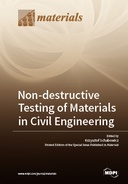Explore

Non-destructive Testing of Materials in Civil Engineering
Krzysztof Schabowicz
2019
0 Ungluers have
Faved this Work
Login to Fave
This book was proposed and organized as a means to present recent developments in the field of nondestructive testing of materials in civil engineering. For this reason, the articles highlighted in this editorial relate to different aspects of nondestructive testing of different materials in civil engineering—from building materials to building structures. The current trend in the development of nondestructive testing of materials in civil engineering is mainly concerned with the detection of flaws and defects in concrete elements and structures, and acoustic methods predominate in this field. As in medicine, the trend is towards designing test equipment that allows one to obtain a picture of the inside of the tested element and materials. From this point of view, interesting results with significance for building practices have been obtained
This book is included in DOAB.
Why read this book? Have your say.
You must be logged in to comment.
Rights Information
Are you the author or publisher of this work? If so, you can claim it as yours by registering as an Unglue.it rights holder.Downloads
This work has been downloaded 281 times via unglue.it ebook links.
- 184 - pdf (CC BY-NC-ND) at Unglue.it.
Keywords
- acoustic emission
- acoustic emission AE
- acoustic methods
- acoustic spectrum
- active thermography
- adhesion assessment
- adhesive joints
- adsorption
- Artificial Neural Networks
- asphalt mixtures
- autoclaved aerated concrete (AAC)
- Brittle Fracture
- Building materials
- building partition
- Burgers model
- cellulose fibre cement boards
- cement-based composites
- Cesium
- Civil engineering
- compressive strength
- Concrete
- concrete corrosion
- concrete elements
- concrete mix design
- concrete slabs and floorings
- concrete strength
- concrete strength prediction
- corrosion processes
- creep test
- crowd-induced excitation
- damage
- damage detection
- Data mining
- data noise
- deconvolution
- defect detection
- Defects
- degree of degradation
- destruction process
- diagnostic
- Diagnostics
- drilling resistance
- durability
- eddy-current method
- excitation frequency
- fatigue tests
- fiber cement boards
- fibre-cement boards
- four point bending beam
- gantry crane
- GPR method
- horizontal casting
- Lamb waves
- Lead
- location of inclusions
- Machine learning
- masonry structures
- materials research
- mathematical morphology
- mercury intrusion porosimetry
- micro-computed tomography
- Microstructure
- moisture of AAC
- moisture safety
- monitoring of structures
- multiple feedbacks
- nanoindentation
- natural frequency
- NDT methods
- non-destructive evaluation
- non-destructive method
- non-destructive methods
- non-destructive testing
- Nondestructive testing
- pattern recognition
- precipitation
- quasi brittle cement composites
- rebar location
- rebound hammer
- reinforced concrete chimney
- reinforced concrete grandstand stadium
- reinforced concrete tanks
- resistance measurement
- RMF technique
- scanning laser vibrometry
- SEM
- SEM-EDS analysis
- service life of a structure
- shape and size of specimen
- SilverSchmidt
- singular value truncation
- solid-state NMR spectroscopy
- spun concrete
- strengthening
- stress wave
- structural damage
- Structural health monitoring
- structural tuning
- sulphate corrosion
- surface complexation
- temperature
- thermal contrast
- thermography
- thermovision
- timber structures
- Ultrasonic testing
- ultrasonic tests
- ultrasonic tomography
- ultrasonic wave
- ultrasound
- ultrasound measurements
- ultrasound tests
- vibration analysis
- viscoelastic parameters
- waste brick dust
- wood moisture sensing
- X-ray computed tomography
- X-ray micro-computed tomography
Links
DOI: 10.3390/books978-3-03921-691-8Editions


